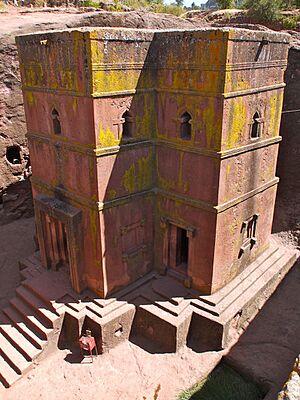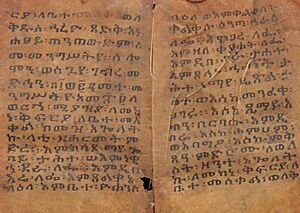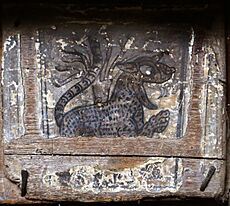Zagwe dynasty facts for kids
Quick facts for kids
Zagwe dynasty
ዛጔ መንግሥት (Amharic)
|
|||||||||
|---|---|---|---|---|---|---|---|---|---|
| 1137–1270 | |||||||||

Christian territories during the Zagwe Dynasty circa 1200 AD
|
|||||||||
| Capital | Lalibela | ||||||||
| Common languages | |||||||||
| Religion | Ethiopian Orthodox Tewahedo (official) | ||||||||
| Demonym(s) | Ethiopian Habesha |
||||||||
| Government | Monarchy | ||||||||
| King | |||||||||
|
• early 12th century
|
Mara Takla Haymanot | ||||||||
|
• 13th century
|
Yetbarak | ||||||||
| History | |||||||||
|
• Established
|
1137 | ||||||||
|
• Other theories for the start
|
c. 930 | ||||||||
|
• Battle of Ansata
|
1270 | ||||||||
|
|||||||||
The Zagwe dynasty (Amharic: ዛጔ መንግሥት) was a powerful kingdom in the northern parts of Ethiopia and Eritrea during the Middle Ages. It was ruled by the Agaw, an ethnic group native to the highlands of this region. The Zagwe kingdom was based in a city called Roha, which is now known as Lalibela. It ruled from about 1137 to 1270 AD. The last Zagwe king, Za-Ilmaknun, was defeated in battle by the Amhara King Yekuno Amlak. The Zagwe dynasty is most famous for its king Gebre Meskel Lalibela. He is known for ordering the building of the amazing rock-hewn churches in Lalibela.
The name "Zagwe" probably comes from the old Ge'ez phrase Ze-Agaw. This means "of the Agaw people." It refers to Mara Takla Haymanot, who started the dynasty. Interestingly, this name doesn't appear in writings from that time.
The Zagwe kings mainly ruled the highlands of modern Eritrea, Tigray, Wag, Bete Amhara, and areas towards Lake Tana. Unlike later rulers, it's believed that under the Zagwe, brothers often became king after each other. This was based on the Agaw people's traditional laws of inheritance.
Contents
A Look Back: History
How the Dynasty Began
One story says that around 960 AD, Queen Gudit destroyed what was left of the Kingdom of Aksum. This caused the main power center to move south. She ruled for 40 years, and her family continued to rule. Later, Mara Takla Haymanot married the daughter of the last Aksum king, Dil Na'od.
Another tradition says that Mara Takla Haymanot overthrew Dil Na'od in 1137. Mara was from the province of Lasta, which became his power base. He was a general for Dil Na'od and married his daughter, Masoba Warq. He then took over the kingdom.
Some old writings found in Axum mention two Christian kings, Dabra Ferem and his son Hasani Dan'el. These kings are not on the usual lists of Ethiopian rulers. They likely ruled in the early 10th century when the power of the older Solomonic kings was fading. Some historians think these kings might have been early leaders related to the Zagwe dynasty.
Mysteries of the Zagwe Period
The Zagwe period is still a bit of a mystery. Even the exact number of kings is debated! Some old records list eleven kings who ruled for 354 years. Others list only five kings who ruled for 143 years. There's even a list with 16 names. Most historians think the shorter time period is more likely.
For example, a letter sent to the leader of the church in Alexandria around 1150 AD asked for a new church leader. This letter was likely from King Mara Takla Haymanot. He wanted a new leader because the old one wouldn't support his new dynasty.
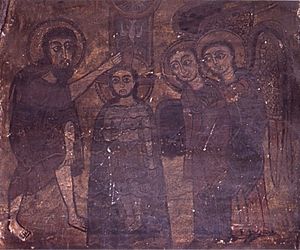
The End of the Zagwe Dynasty
The end of the Zagwe dynasty is also unclear. The name of the last Zagwe king is not known for sure. Old stories call him Za-Ilmaknun, which means "The Unknown, the hidden one." This name was probably used by the new rulers to erase his memory. Many historians believe the last ruler was actually Yetbarak.
The Zagwe rule ended when Yekuno Amlak defeated them. Yekuno Amlak was guided by religious figures like Saint Tekle Haymanot. He chased the last Zagwe king and killed him at the Battle of Ansata. This battle marked the beginning of the new Solomonic dynasty.
Kings and Their Titles
Zagwe kings used the traditional Ethiopian title of negus, which means "king." King Lalibela also called himself hasani. This word means "tutor," "nurse," or "counselor." This title was first mentioned in the 10th century for an Ethiopian king. It also appears in some old Ge'ez writings and a land grant from King Tatadim around 1030 AD.
After Lalibela's time, the title hasani was no longer used for kings. By the 14th century, it was used for a governor of a province instead. Like the kings of Aksum before them, Zagwe kings had three names: a baptismal name, a name they used as king, and a family name.
Connections with Other Lands
Unlike the earlier Aksum kingdom, the Zagwe dynasty was not well-known to other powerful countries around the Mediterranean Sea. They mostly had contact with Egypt and Jerusalem. Ethiopians are known to have lived in Egypt in the 11th and 12th centuries. A piece of a Ge'ez manuscript found in an Egyptian monastery confirms their presence during the Zagwe rule.
Ethiopians also had a community in Jerusalem by the late 13th century, and probably even earlier. King Lalibela knew a lot about Jerusalem. This knowledge inspired him when he expanded his capital city. He made his city look like Jerusalem and used similar names for places.
Islam in the Zagwe Period
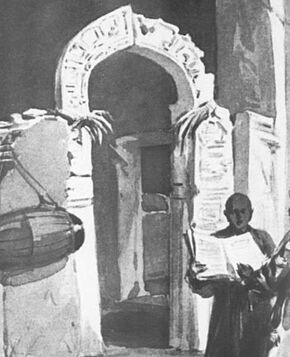
According to Muslim tradition, some followers of the Prophet Muhammad lived in Ethiopia in 622 AD. This happened after they were forced to leave Mecca. However, there's no archaeological proof of this.
There is evidence of Muslim communities in eastern Tigray during the Zagwe period. They might have been Shiites who had ties to the Fatimid rulers in Egypt. Old Arabic tombstones found near Qwiha show that a Muslim settlement existed there between the 10th and 12th centuries. More recent digs found a Muslim cemetery at Bilet, used from the late 10th to mid-13th century. Most of the tombstones are from the 11th century. The names on the tombstones suggest links to Egypt, the Arabian Peninsula, and even Iran.
Another Muslim cemetery was found at Arra, about 30 kilometers south. It was used from the mid-12th to mid-14th century. A broken stone decoration with old Arabic writing in the Wukro Chirkos church probably dates to the late 11th century. It might have originally been from a mosque. The Muslim community in Tigray became smaller from the 12th century onwards. This was partly because the Fatimid rulers lost power. Also, if a land grant by King Tantawedem is true, the Zagwe kings might have taken away their land.
Kings of the Zagwe Dynasty
Old records and writings show different lists of Zagwe kings and how long they ruled. There are three main versions: the 'short', 'long', and 'longer' lists.
Short List
This list, recorded by Pedro Páez, has 5 kings:
- Mara Takla Haymanot (13 years)
- Yemrehana Krestos (40 years)
- Lalibela (40 years)
- Na'akueto La'ab (40 years)
- Harbai (8 years)
These kings ruled for about 141 years, from around 1179 to 1270 AD.
Long List
This list, recorded by Carlo Conti Rossini, has 11 kings:
- Mara Takla Haymanot (3 years, though some records say 13)
- Tatadim (40 years)
- Jan Seyum (40 years)
- Germa Seyum (40 years)
- Yemrehana Krestos (40 years)
- Kedus Harbe (40 years)
- Lalibela (40 years)
- Na'akueto La'ab (48 years, though some records say 40)
- Yetbarak (40 years, though some records say 17)
- Mairari (15 years)
- Harbai (8 years)
These kings ruled for about 354 years, from around 916 to 1270 AD.
Longer List
This list has 16 kings:
- Mara Takla Haymanot (13 years)
- Sibuhay (Dil Na'od II) (10 years)
- Mairari (15 years)
- Harbai (8 years)
- Mengisine Yitbarek I (7 years)
- Yi'kebke Egzi (10 years)
- Zena Petros (6 years)
- Bahr Saf (14 years)
- Tatadim (Ser Asagad) (10 years)
- Akotet (Jan Seyum) (20 years)
- Be'mnet (Germa Seyum) (20 years)
- Yemrehana Krestos (40 years)
- Gebre Maryam (Kedus Harbe) (40 years)
- Lalibela (40 years)
- Na'akueto La'ab (40 years)
- Yetbarak II (40 years)
These kings ruled for about 333 years, from around 937 to 1270 AD.
See also
- Ethiopian historiography
- History of Ethiopia
- Kings of Axum
- List of Emperors of Ethiopia


